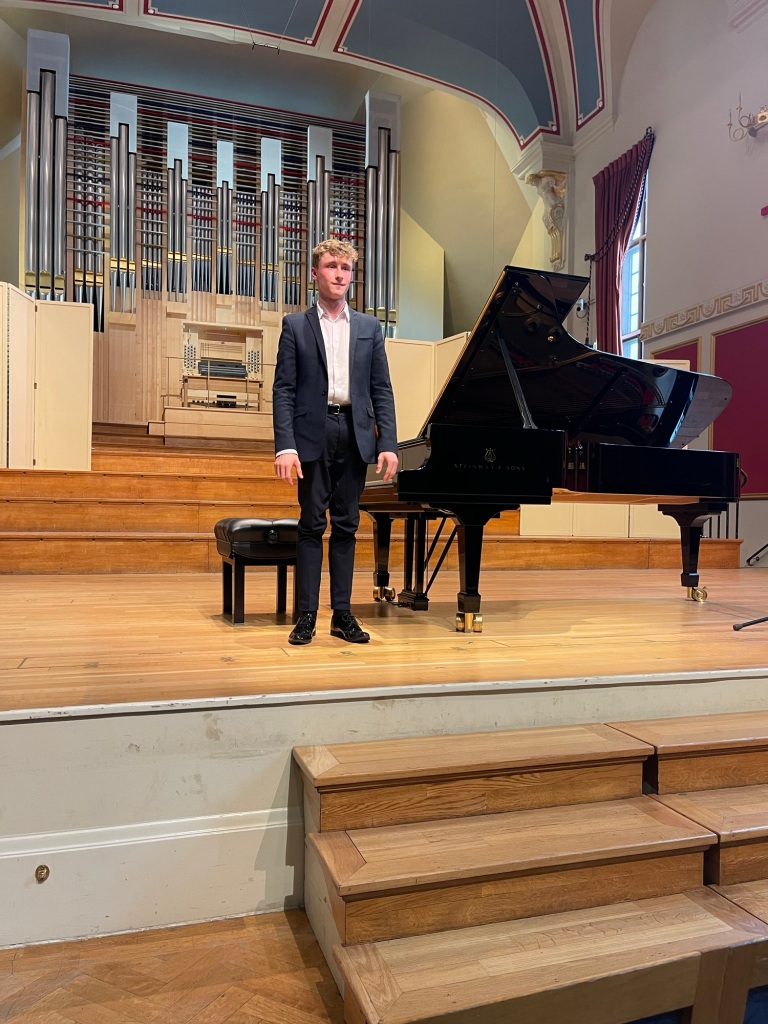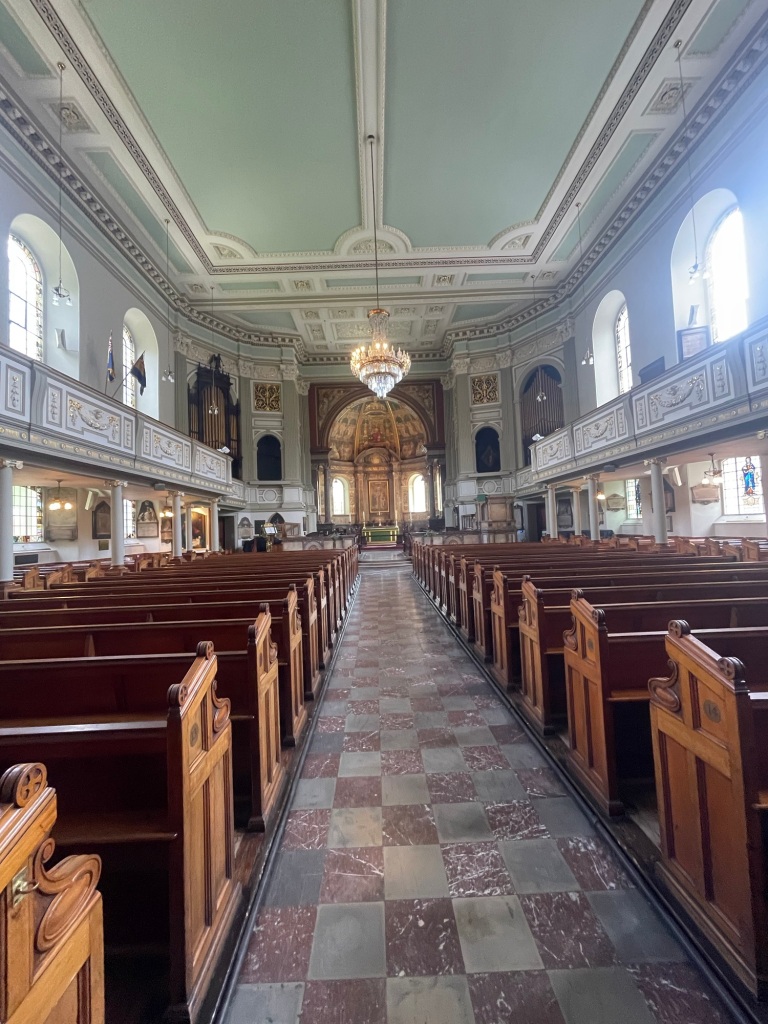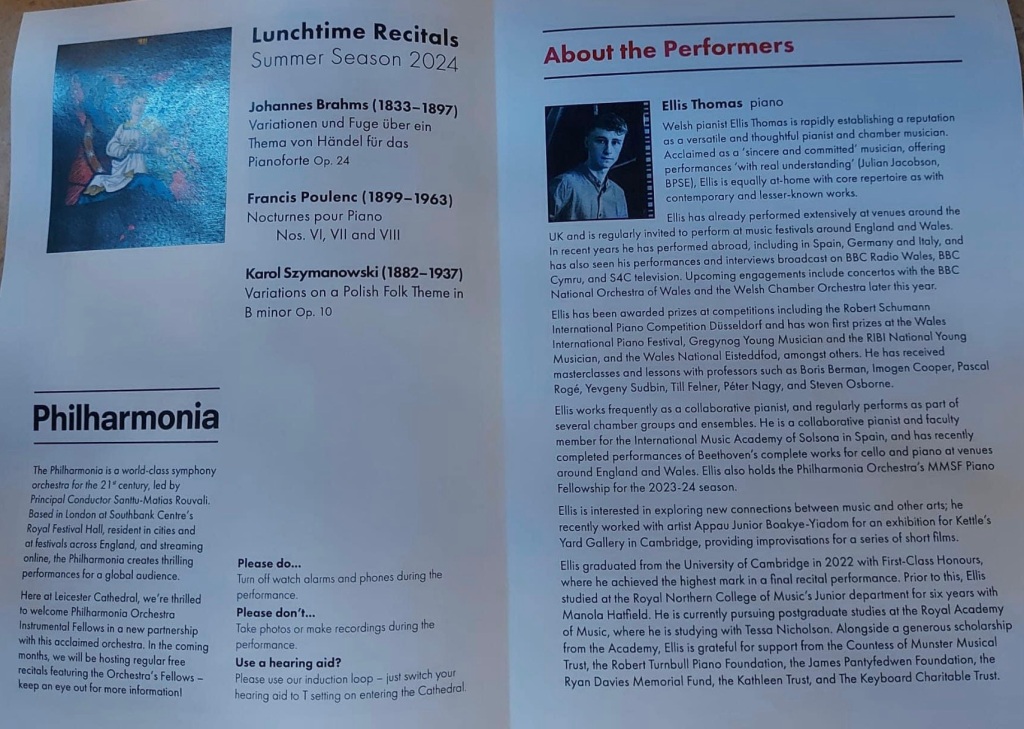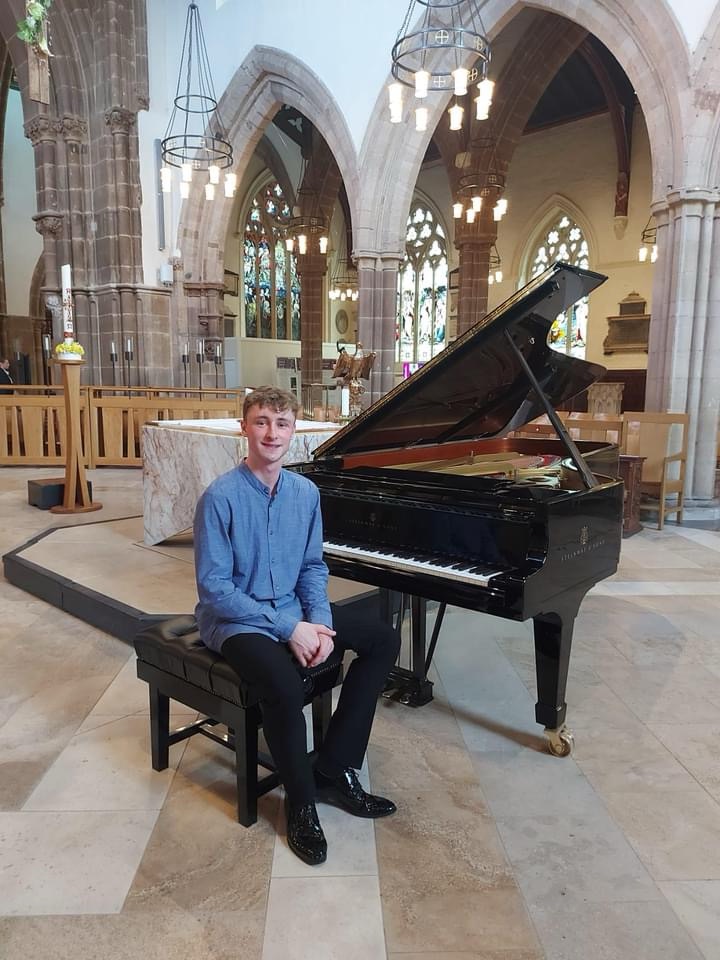
Ellis Thomas at the Royal Academy for his final graduation recital
Nice to be back after my own trial by fire in 1972 on this very stage !
But for Ellis already with a degree from Cambridge under his belt and with the tireless dedication of his great teacher Tessa Nicholson he was enjoying every minute of his hour long recital in one of the most beautiful halls in London and certainly one of the finest Steinway concert grands in the city.

Brahms’s Handel variations were played from the very first notes with a clarity and rhythmic drive that kept us hypnotised from the first note of Handel’s innocent theme to the final mighty chords of the fugue that had inspired Brahms .
It was this clarity that made one realise that unlike the sonatas that are disguised symphonies these variations are purely instrumental and the technical mastery that Ellis demonstrated was quite remarkable
Hardly ever using the ‘soft ‘ pedal as he was able to control the sounds purely with his sensitive agile fingers and show us the architectural shape and inevitability of the triumphant outpouring of Handel’s innocuous theme.The mighty fugue whilst still maintaining remarkable clarity suddenly became more orchestral as he allowed himself more pedal to build up the enormous sonorities that were truly ‘Brahmsian’.
It just goes to show his courage and artistic conviction that he could think to present two rarely heard works in his farewell recital.
Poulenc’s Nocturnes and Szymanowski’s youthful variations on a Polish Theme op 10 were on the menu.
What a discovery too when played with such fantasy and kaleidoscope of colour not to mention a transcendental mastery of sound especially in Poulenc.But also a technical mastery in the Variations where he was totally in control and without a moment of hesitation or having to turn corners more gently he just threw himself fearlessly into the fray with searing energy and dynamic drive.
Another great artist on the horizon for the indomitable Tessa Nicholson school.

Passing by the sumptuous waiting room I noticed a bust that I thought was Myra Hess who always used to sit so regally there in my day.But no it was that other great ‘M’ of Uncle Tobbs, Moura Lympany ……..dear Moura always so elegant how she would have hated to be remembered like this!

Over the road too there is a plaque to where Leonard Stokes went to school within the gardens of the magnificent church that sits opposite the Academy.Just shows how one can have the head in the sand as it has taken me over fifty years to venture in and marvel at what I missed during my five student years just over the road!








Karol Maciej Szymanowski 3 October 1882 – 29 March 1937
The Variations on a Polish Theme, Op. 10, by Karol Szymanowski (1882-1937) are a youthful extravagance. Szymanowski was in his late teens when he arrived in Warsaw in 1901 and began composition lessons with Zygmunt Noskowski, to whom he dedicated these Variations. The work seems to have been completed by 1904, and received its premiere in 1906 on a concert featuring music by Young Poland in Music, a small activist group of composers that Szymanowski helped found.
The variations draw their theme from a tune in Jan Kleczyński’s book O muzyce podhalańskiej / On the Music of Podhale (1888); interestingly, this tune will reappear in Harnasie a few years later.
Understandably Chopin-besotted at the time, Szymanowski was also much influenced by Scriabin, whose own early music was similarly indebted to Chopin. He launches these B-minor Variations with a sad little introduction, Scriabin evident in its restless chromaticism and Chopin in the five-against-four filigree. The Theme itself – prefigured in the introduction – begins with a modal statement of the main melodic material in soft octaves, although the descending chromatic slither that quickly follows will be equally important.
Traditional passages that follow the nineteenth-century pattern (such as the final variation with the four-voice fugue) exist side by side with more individualized ones in which Szymanowski’s creativity manifests itself alongside his mastery. Such is for example the moving, tense variation No. 8, its form that of a funeral march.
Ten connected variations follow, the first nine of which are diverse A-B-A miniatures. Variation VI takes us to sweet B major, and Variation VII (also in B major) is a lightly rustling metrical experiment, with the right hand in 9/16 and the left in 6/16. The eighth Variation is a doleful funeral march in the remote key of G minor. Variation IX, back in B major, is basically a prelude for the finale, which is a complex, triumphant monster nearly as long as the others combined. In many ways it is almost a parody of late Beethoven, filled with violent contrasts, mystical trilling, and broad spaces between the depths and the heights. There is even a buffo fugue on the theme, marked “mit Humor,” and a heroic coda to close.

Francis Jean Marcel Poulenc 7 January 1899 – 30 January 1963
The set of eight nocturnes as we know it today is a result of long years of work. The first Nocturne was finished in 1929. The Nocturne No. 2 was composed in 1933, Nocturnes No. 3 to No. 6 were finished by 1934, No.7 in 1935, and the concluding piece was added in 1938. The Nocturnes were not intended to form a cycle until 1938, when Poulenc decided to include them in one collection. The entire set was published in 1939. Given the kaleidoscopic nature of Poulenc’s writing, his Nocturnes do not obey the classic laws of musical structure where the English-language scholarship tries to make them fit. The interest of these pieces lays in the superposition of the layers of sound, in the extraordinary experiments with the piano resonance, very intimate sensitivity, and subtle, witty, and fine humor.
Nocturne No.1 in C major features a simple singing melody and harp-like arpeggios in the accompaniment. There are three instances in which the theme returns, and three contrasting sections, giving the impression of a rondo. Poulenc adds a little coda, which rather than resuming the action occurred during the piece, offers a new shed of light and a new emotion.
While writing his Nocturne No.2 Poulenc must have had in mind the young Janine Salles, to whom the piece is dedicated. We only can imagine how beautifully she danced, since this piece has a flavor to certain numbers of ballets by P. Tchaikovsky.
Les cloches des Malines (No.3) brings to the pallet the foggy colors of distant bells in the dusk. The faraway resonances give place for an instant to closer ones, returning soon to the surreal sounds of the beginning.
The fourth Nocturne, preceded by a quote from Julien Green’s “Le Visionnaire”, pictures an old man in his sick bed remembering the pleasures of his youth. It is a nostalgic mix of a waltz and a mazurka.
Nocturne No.5 depicts night bugs (Phalènes – Moths), randomly flying around the lanterns and swiftly changing directions.
Nocturne No.6, contrary to the suggestions of the scholars, represents in my opinion a beautiful eulogy to Poulenc’s dear friend and intended wife, Raymonde Linossier, who tragically passed away in 1930. The strong emotional charge of the piece and the use of traditional eastern musical means support the theory of a musical homage to the late Raymonde Linossier, who specialized in Eastern cultures and before her tragic death had organized an exposition of Indian and Tibetan art at The Guimet Museum in Paris.
As is usual for Poulenc, in Nocturne No.7 he changes completely the mood and turns to a light-hearted almost popular tune.
However, the last Nocturne, added much later, in a way summarizes the cycle and brings the ends together. The simplicity of the harmony, the diatonic harmonization, and a coda that quotes the coda from the first nocturne blend beautifully in a nostalgic closure to the cycle.